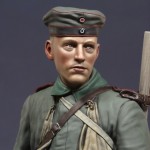
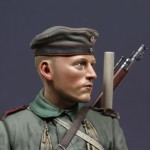


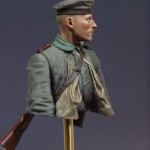



Above are the painted bust photos from David Lane






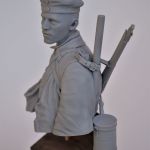

The photos above are of the actual parts within kit and the assembled resin bust, showing the alternative heads supplied. The photos below are snapshots from the 3D program used to create the master figure



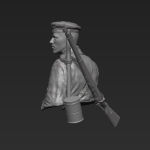
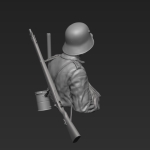
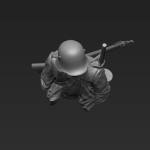
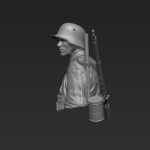

German Sapper Sturm-Btl. Nr. 5 (Rohr), 1916 – Dt. Pionier, Sturm-Btl. Nr. 5 (Rohr) 1916
- Scale / Maßstab: 1:10
- Approx. height of bust / ca. Höhe Büste: 65mm
- Material: Resin (bust), 6mm Brass Tube (for bust mount) / Resin (Büste), 6mm Messing-Rohr (für Sockel montieren)
- Parts / Teile: 16
- Infosheet / Infoblatt: English
- Code: 31BST
Contents Bust / Inhalt Büste:
- Upper Body / Oberkörper
- Head for Helmet / Kopf für Stahlhelm
- 2nd Alternative Head with Prussian Field Cap M1910 / 2. Alternativ-Kopf mit Preußische Feldmütze für Mannschaften M1910
- Steel Helmet M1916 / Stahlhelm M1916
- Chin Strap / Kinnriemen
- 2 x Grenade Bags / 2 Stck. Tragebeutel für Handgranaten
- Gas Mask Tin M16 (early version) / Bereitschaftsbüchse M16 (alte Art)
- Gas Mask Tin Strap Section / Bereitschaftsbüchse-Riemen
- Pioneer Pickaxe (shaft only) / Pionier Kreuzhacke (nur Stiel)
- Utility Strap for Pickaxe Shaft / Riemen für Kreuzhacke Stiel
- Mauser Carbine 98 AZ with Muzzle Protector (now in 2 parts) / Mauserkarabiner 98 AZ mit Mündungsschoner (jetzt in 2 Teile)
- 2 x Sling Sections for 98 AZ / 2 Stck. Riemen für 98AZ
- 6mm Brass Tube (for bust mount) / 6mm Messing-Rohr (für Sockel montieren)
About this Bust
The bust depicts a young sapper of a German Pioneer unit, in this case the famous Storm Battalion No. 5 (Rohr). This experimental training unit, founded by Major Calsow in the spring of 1915 and later commanded by Hauptman Willy Rohr, formed the nucleus of the new infiltration assault tactics. Equipped with infantry support guns and large body shields, the originally named Sturmabteilung Calsow or SA Calsow was ordered to the front in June 1915 to counter an Allied attack, losing half its members by the time the unit was withdrawn from the front. Calsow was relieved of his command and Hauptmann Rohr took over the detachment from September, adding an MG and flame thrower platoon to the unit strength.
Now promoted, Major Rohr refined the unit’s tactics, discarding the heavy body shields in favour of speed and movement and replacing the cumbersome infantry support guns with new developed models, converted from captured Russian 76.2 fortress guns. The new assault tactics now employed, involved much smaller, independent squads, or Stoßtruppen, supported by heavier weapons, infiltrating the weaker areas within the enemy defences and bypassing strongpoints, to be cleared later by regular trooper. Enemy trench system would now be cleared (or rolled up) by Stormtroopers armed with stick grenades, protected by their own riflemen.
The new tactics called for a different approach to weapons and equipment. Shorter, more practical weapons were employed, such as carbines, pistols, clubs and trench-knifes. Assault equipment was reduced to the absolute minimum required and grenades, ammunition, water and entrenching tools were increased. A rational change in uniform took place, with lighter, ankle-length footwear, loose and simplified tunics being issued, allowing the officers and NCO to become undistinguishable from other troops.
As from December 1915, the battalion started training troops from other units and in February 1916 was transferred to the 5th Army and participated in the initial attacks in the Verdun offensive, leading other assault formations in the first wave. In April 1916, the detachment was increased from 2 to 4 pioneer companies and received the official name Sturm-Bataillon.
Attacks by these Stormtroopers were generally carried out by small units, rarely larger than battalion size. Meticulous planning after local reconnaissance, incl. the aid and reconstruction of life-size enemy defences behind the front, were characteristic of how these units worked.
Overlooked by many historians, is the objection against these Stormtrooper-Detachments amongst their own regular infantry regiments holding the front line. The Stormtroopers would show up for an attack and then move out of the area quickly again afterwards, at latest the next day, leaving behind an agitated enemy desiring revenge.
Extracts from the Infosheet with this Bust:
The German Soldier of 1917 and 1918. The German soldier in 1917/18 had changed somewhat from his comrades of 1914. Firstly, he would have been much younger – on average about 18/19 years of age after finishing training – NCOs a year or two older. His hair would have been kept cropped and as short as possible. The style of his uniform differed not only in quality but functionality as well, with many items of clothing and equipment produced in Ersatz material, or a combination of mixed dress. Infantry companies within the Front Line areas numbered on averaged 75 – 80 soldiers, some as low as 50 (a full company strength would be around 135 men), with the bulk of its fighting capacity and experience held by only 15 – 20 old sweats. As the war progressed more emphasis was put onto automatic weapons and as many as 4 MG 08/15s per Infantry Company were issued.
Field Service Dress Tunic M1915 / Feldbluse M1915: This was to replace the early M1907/10 and the simplified M1914 service dress tunics. All three were in fact worn alongside each other throughout the war. The Bluse was a radical change in the design of combat clothing, with trials before the war and the new experience gained at the Front producing a garment without the unnecessary elements of the earlier tunics, giving the German soldier a completely different, in some cases baggy appearance. Designed for all arms of the service and for all ranks (officers were allowed to acquire the Bluse in a better quality of material, but were not permitted to show difference in colour from the other ranks).
Colour: made out of a field grey material (the Light Infantry units, or Jäger and Schützen wore a green-grey version). All units had the turn down collar in resedagrün reed-green, exception being the Bavarians, who retained the field-grey material, piped on the outer edge (later only the front, vertical edges) in the State colours white / blue Rautenborte, a particular feature of Bavarian troops. The six front horn buttons to the Feldbluse were hidden behind a flap – these had an off-white colour. On early version of the tunic, the small shoulder strap buttons were kept in brass, later these were painted over in various colours, ranging from green to grey.




On the shoulder straps I have raised the battalion numbers somewhat more than would normally be the case – this is to allow for an easier painting application. With a bit of care and a thin knife blade, it is possible to hollow out the gaps underneath and to the rear of both shoulder straps. Here one can use the back end of a sharp knife and scrape away the resin. There is an additional small casting web underneath the end of collar at front of tunic – this should be removed before painting.
Belt M1895 / Koppel M1895: The original belts were issued in natural brown leather, the buckle in brass with a Neusilber / nickel silver inlay. From 1915, leather equipment was officially issued blackened, buckles painted over in grey or manufactured in steel with a grey finish.
I have designed the bust with the Prussian State emblem buckle – a crown and motto GOTT MIT UNS. The belt on the original photo seems slightly off-centre, with the buckle moved around to the right. That this is a Prussian soldier is indicated by the crown shown on the open tunic pocket button (not shown on bust).
Steel Helmet M16 / Stahlhelm M.16: This helmet, which first entered service in 1916 during the initial stages of the battle of Verdun was designed by Professor Friedrich Schwerd and made from high quality chrome-nickel steel. Weighing between 950 and 1200g, depending on size – heavier than the Allied helmets, but giving a better protection to the face, ears and neck. The horn venting bolts on each side enabled the fitting of an extra armoured shield over the helmet for sentries, MG troops, snipers or other particularly exposed / dangerous employment. This weighing around 2000g was seldom used; although a total of 50000 were supposedly produced.




Colour: first issued in field-grey, which would reflect in sun light and proved unsatisfactory. Various trials were carried out, but it was not until July 1918 that an official camouflage scheme in brown and green sharp-edged irregular patens, all outlined in black was introduced. These were carried out by unit maintenance workshops (other weapons and equipment, particularly artillery pieces and MGs were also rendered in the same way). It seems that helmets were re-painted by individuals or units in a variety of colour schemes before the official order and helmets with red-brown, ochre (brownish-yellow), green and blue-grey, all outlined in black were common. Helmets were also covered using the light brown sandbag material, or the issued helmet-covers, seen particularly in the later war period.
The M.17 & 18 helmets followed with only slight differences to the inside padding and chin strap fasteners. The last model to see service during the war, if only in small numbers was the M.18 Ohrenausschnitt, or Helmet M.18 with ear cut-outs, more commonly (and stubbornly) known as the Cavalry or Telegraph Helmet. The cut-outs were in fact a further design feature of the M.18 to improve the hearing ability of the wearer and avoid the hissing noise experienced by troops.
The vent bolts can be drilled out (just as in the original), using a 0.5mm hand drill, making sure that one comes out at the correct angle inside the helmet.
Chin Strap / Kinnriemen: The M16 helmet used the leather chin-straps, with brass slider buckles (later steel) originally supplied with the spiked helmets. These proved to be only partly suitable, as they would often become loose and slip down during wearing.
Gas Mask Tin M16 (early version) / Bereitschaftsbüchse M16 (alte Art): At the beginning of 1915, the early type gas masks were issued without any form of container or holder and were often placed within the haversack (bread bag) or in some cases kept in tins, which were fastened by string around the soldier’s neck. Later in 1915, the Canvas Gas Mask Holder, with dividing sections within was issued – Segeltuchtasche für Gasmaske M1915 – here the mask, filter unit and spare filter were kept in tins within and still had to be opened and attached when required. The holder was officially worn on the left side of belt, but is quite often seen at rear, next to the haversack.
In March 1916, the German War Ministry announced the distribution of a Gas Mask Tin, which held the ready for use mask with filter unit already attached. Until the issuing in sufficient numbers, the troops had to do with tins of different manufactures, including the existing canvas holders being modified to carry the mask with filter unit attached.
In June 1916 the Gas Mask Tin M16 / Bereitschaftsbüchse M16 was issued, together with a leather strap, later made from canvas for attachment around the neck. The bottom tin attachment loop could also be attached to a front tunic button, holding the tin in the standby position. If not in this position, the gas tin was kept as before within the canvas holder or slung around the back. Within the tin, the mask could be kept with filter unit attached and ready for use. The gas tins were used until the end of the war, but parallel the new and slightly higher M17 tins were being issued from mid-1917.
Colour: original items show a diversity of colours used on these tins, ranging from field-grey to dark or Khaki-green.
Studying the original photo, one notices that the gas tin is of a different version than the normal M16 types shown in many uniform / equipment books on this subject. This tin however seems not to be that uncommon when examining photos from this period. The main differences compared to the standard versions are the larger size, inward middle support or strengthening indentation (rather than outwards) and the simple hinge and fastening method.
On the model tin there is a seam running from top to bottom on the side – this is the overlap join when the tin was manufactured, distinctive on the original items. The area behind the 3 strap attachments has been filled out slightly for casting reasons – this can be removed if required. The position of the tin on outer, lower edge of bust means that it has little support on its own. I would suggest pinning this item to bust body for added adhesion.


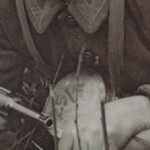

Mauser Carbine 98 AZ / Mauserkarabiner 98 AZ: (more commonly known as the Kar. 98 AZ) AZ stands for Aufplanz- und Zusammensetzvorrichtung – or stacking hook – one could stand the carbines up in 3s linked to each other by means of the metal hook, at the end of the barrel. Although designated as a 2nd line weapon, designed for support troops, cavalry etc., many did end up being issued to Stormtrooper units. The Carbine 98 AZ, which was shorter and therefore easier to handle than the standard issued Gewehr 98 rifle used by the infantry proved just as useful. They both had about the same performance within the reduced ranges of trench warfare. A further advantage over the Gewher 98 was that the turn-downed bolt folded against the stock of the carbine with an added undercut into the wood, therefore reducing the danger of being snagged on uniforms and equipment etc. The bolt handle also had a chequered under surface to increase grip. The side-slug sling attachment allowed for a better handling when one was using their hands (cavalry, artillery) and not just marching.




Some examples of the Kar. 98 AZ show the indented finger grooves on the stock – these were a war-time modification, still seen on many of the post-war carbines, now found in museums and with collectors.
Unmistakable on the original photo is the muzzle protector attached to the end of carbine barrel, in front of the foresight. The front of the protector had a hinged cap, which could be lifted upwards if required in a hurry.
Brass Tube: The 6mm buffed diameter brass tube supplied is to mount the bust to a suitable stand. Under the bust, an appropriate hole has been modelled in a middle / forward position to allow the figure to be displayed. The hole will require to be drilled further into bust and is slightly larger than 6mm – this is to allow for a choice of positions / angles as required.
 An deutschsprachige Interessenten:
Sie können mich per eMail oder Telefon auch gerne auf deutsch kontaktieren. Ortsbesuch ist nach Absprache möglich.
An deutschsprachige Interessenten:
Sie können mich per eMail oder Telefon auch gerne auf deutsch kontaktieren. Ortsbesuch ist nach Absprache möglich.
